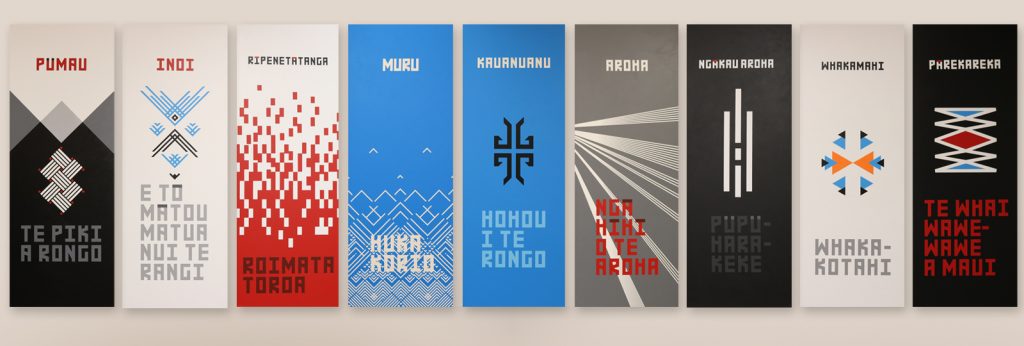
Ngā tukutuku o te kāinga: The Family and Tukutuku
Acrylic on canvas 1600 x 600mm, 9 pieces.
These nine pieces are based on nine principles identified to have successful marriages and families from The Family: A Proclamation to the World.[1]
My wife and kids are the most important things to me and so I have always been interested in simple things to do to be a better husband and father. I have not always done this well, but I have gotten back on my bike and peddled again or walked along side it. The home is the most important building in the World. It is a place of safety, protection, learning and love. The nine principles are:
Work and
Text, fonts have always fascinated me. They are simple shapes that when put together in an organised pattern communicate messages. I couldn’t (and still struggle to) read them well, but the shapes looked like there was information in them that needed to be known. I saw patterns in them and noticed that the different styles of fonts added to the story and so styles of fonts were as important as what they are communicating. To be honest, reading has always been a challenge to me, as a kid I would go to the second-hand bookshops to look for comics, but not just any comics, ones that had hardly any words in them. Funny aye, for someone to like text but not to like reading them, but it is the shapes of the text/fonts that I liked, not the reading of them.
The fascination of fonts extended to tukutuku in the whare tupuna. When I first saw them, they were words, but like the fonts I have seen, I did not know what they were saying, but the forms were beautiful to look at. They communicate stories using simple shapes. These shapes form patterns, in an organised way and the patterns repeat giving meanings to those stories. The stories remind us of lessons that others have learnt and remind us of our potentials.
These are reasons why I have used text and tukutuku together in these pieces. But to get me to these designs I went through a process to see if the existing tukutuku would even match the nine principles and if they didn’t, is it tapu to design new ones?
The use of Tukutuku Designs
Te Rangi Hīroa said that any house (meaning whare tupuna) without tukutuku had a feeling of incompleteness, even poverty.[2] This was the basis of the theme of these nine pieces in seeing the link with family and tukutuku. However, there were only six to eight different tukutuku patterns that I have seen. There are more, I don’t the meanings. Some of the tukutuku patterns include kaokao (meaning courage, preparedness), whetu (stars), patiki (the flounder – plentiful). These are simple meanings, to something much deeper, for example the roimata toroa pattern tells of the story of Pourangahua who had been given use of two albatross with strict conditions. Pourangahua did not follow the conditions and lead to the demise of the birds and thus the tears of the albatross (roimata – tears and toroa – albatross). However, I could not match existing tukutuku to the nine principles. I have seen other historical images of tukutuku, but they did not include meanings and stories.
I read about Apirana Ngata’s Rotorua School of Māori Arts and Crafts started in 1927 that revived the Māori arts including tukutuku.[3] Ngata also recognised the changing environment and that
“as Māori adopted Pākehā ideas and technologies for their own purposes, but in a way that was driven by Māori needs and aspirations.” [4]
This led me to believe that modern takes or the development of new patterns and patterns based on modern forms would be acceptable. And if you think about it, Pākehā introduced new technology, such as the horse [5] (hōiho) and so Māori words were developed for these new objects and we call them transliterations (the use of transferring a word from the alphabet of one language to another). [6]
Ngata’s drive for excellence was shown when he was known to have taken student’s work and unravelled them if it was not done well enough.[7] This means that all art or any activities, if done, must be done with care with an aim of excellence.
Men traditionally did tukutuku because of the tapu of building a whare tupuna (only men were able to do this). At the time, tukutuku formed part of the structure and insulation of the walls, but because of the newly introduced building standards, tukutuku could no longer form the structure, so Ngata was able to remove it from the building of whare tupuna and then he introduced women to the tukutuku process,[8] thus removing the tapu of the tukutuku.
Ngata, also did a variation of the whetu pattern, using contrasting colours to make it not so monotonous. This was done on the Raukawa meeting house.[9] Therefore, further evidence that creating variation of tukutuku is acceptable.
Tukutuku has to work within bounds of the materials used and working within a grid to create a tukutuku panel. One of these bounds include straight lines, horizontal, vertical and diagonal because of the grid base used for tukutuku (although I have seen contemporary tukutuku with curves).
These got me to consider that I could develop my own tukutuku patterns, with meanings if I followed these principles:
- Firstly, it is ok to create new tukutuku, because we see and experience new things in a different context for our tupuna and, as Ngata was able to move tukutuku creation away from tapu and allowing women to also do this role.
- Use of straight lines (up, down and diagonals) because of how the panels are made.
- The designs had to follow something natural (not man made) or
- Follow, represent an action or behaviour of people or nature (animals, plants, weather, landscapes)
- The patterns could exaggerate a specific action or pattern in these actions. It did not need to include an entire picture. For example roimata toroa does not have an albatross, it only has representation of the tears.
- The patterns needed to be stripped back and simplified to the main theme of the action, object or thing.
So I created eight new tukutuku patterns and used an existing tukutuku pattern (roimata toroa) for the nine principles of successful marriages and families.
[1] https://www.churchofjesuschrist.org/study/manual/the-family-a-proclamation-to-the-world/the-family-a-proclamation-to-the-world?lang=eng (11 April 2020)
[2] Damian Skinner, (2016), The Māori Meeting House: Introducing the Whare Whakairo, Te Papa Press, Wellington
[3] See footnote 2.
[4] See footnote 2, p 74.
[5] Anaru, Anaru, Norman Albert (2011), A Critical Analysis of the Impact of Colonisation on the Māori Language through an Examination of Political Theory, MA Thesis, Auckland University of Technology, Auckland.
[6] https://www.vocabulary.com/dictionary/transliteration (accessed 25 April 2020)
[7] See footnote 2.
[8] See footnote 2.
[9] See footnote 2.
Te Whare Tukutuku explanations:
